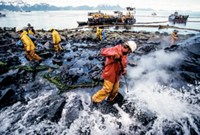Advertisement
Grab your lab coat. Let's get started
Welcome!
Welcome!
Create an account below to get 6 C&EN articles per month, receive newsletters and more - all free.
It seems this is your first time logging in online. Please enter the following information to continue.
As an ACS member you automatically get access to this site. All we need is few more details to create your reading experience.
Not you? Sign in with a different account.
Not you? Sign in with a different account.
ERROR 1
ERROR 1
ERROR 2
ERROR 2
ERROR 2
ERROR 2
ERROR 2
Password and Confirm password must match.
If you have an ACS member number, please enter it here so we can link this account to your membership. (optional)
ERROR 2
ACS values your privacy. By submitting your information, you are gaining access to C&EN and subscribing to our weekly newsletter. We use the information you provide to make your reading experience better, and we will never sell your data to third party members.
Environment
Dispersants Don't Increase Toxicity Of Oil
Gulf Oil Spill: EPA data show that mixtures of oil and dispersant are just as toxic to marine life as oil alone
by Elizabeth K. Wilson
August 3, 2010
Mixtures of crude oil and the dispersant chemicals used to break up oil slicks appear to be no more toxic to sensitive marine life than the oil itself, the Environmental Protection Agency announced on Aug. 2, at a press briefing.
Last month, EPA presented results comparing the toxicities of eight commercial dispersants, which showed them to be similarly toxic, although still less toxic than oil itself (C&EN Latest News, July 8).
This new study, said Paul Anastas, assistant administrator for EPA's Office of Research & Development shows that these same eight dispersants, when mixed with sweet crude oil, are equally toxic to mysid shrimp and silver fish as the crude oil alone.
Since the April 20 explosion of BP's Deepwater Horizon oil rig in the Gulf of Mexico, millions of gallons of oil have poured into the sea, making the incident one of the largest oil spill disasters in history. BP dumped millions of gallons of the dispersant Corexit onto the oil slicks that formed on the ocean surface.
Although the company has capped the leaking well and ceased using dispersants for the time being, scientists are aggressively pursuing studies that will characterize the disaster's effects on the environment.
Concerns about the toxicity of dispersants prompted the EPA studies.
However, these results are "very premature," says Ronald J. Kendall, chair of the Department of Environmental Toxicology at Texas Tech University, Lubbock. "We've got a couple of organisms tested under favorable conditions," he says. Animals that live in the cold, dark, high-pressure environment thousands of feet below the sea, where large quantities of oil still reside, may respond quite differently to the contaminants, he adds.
Samantha Joye, marine sciences professor at the University of Georgia, Athens, concurs. "Conclusions like this need to be based on thorough testing against multiple species, and the findings should be verified independently by multiple labs," she says.
Kendall is slated to testify before the Senate Committee on Environment & Public Works on dispersant use in the Gulf of Mexico on Aug. 4.
"We will continue to monitor the area to understand long-term effects," Anastas said at Monday's press conference. "We have taken nothing for granted."





Join the conversation
Contact the reporter
Submit a Letter to the Editor for publication
Engage with us on Twitter